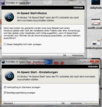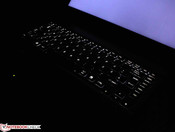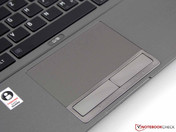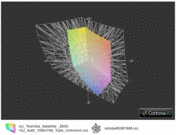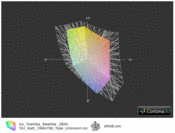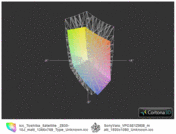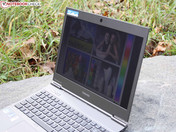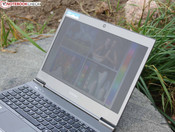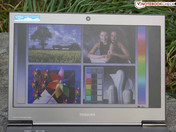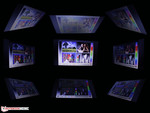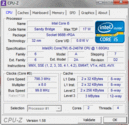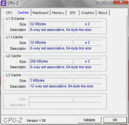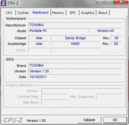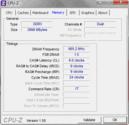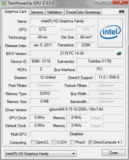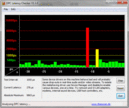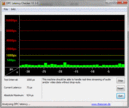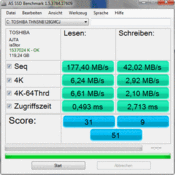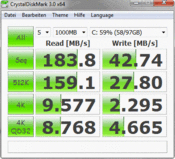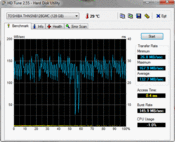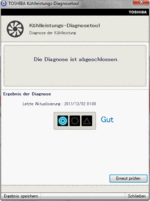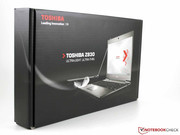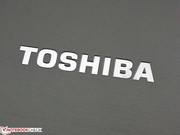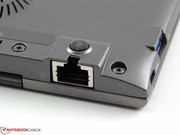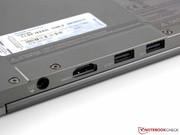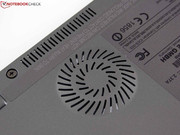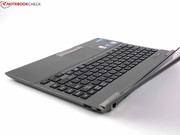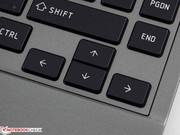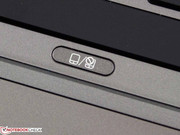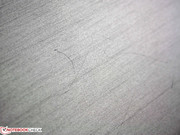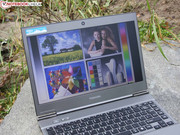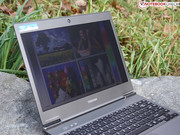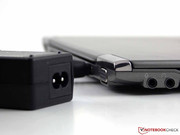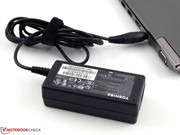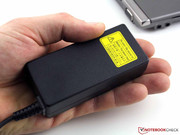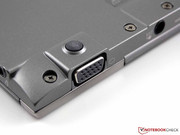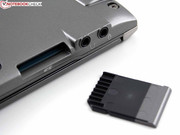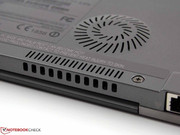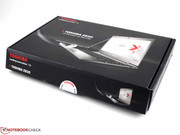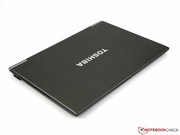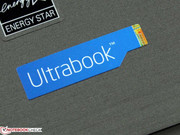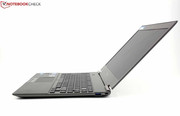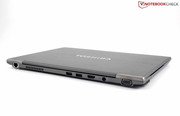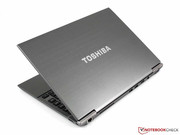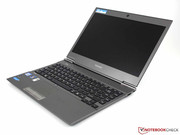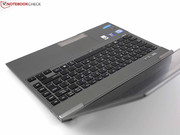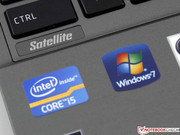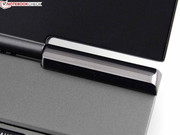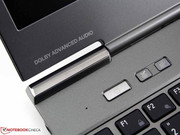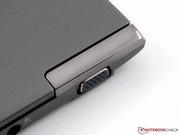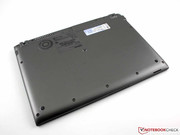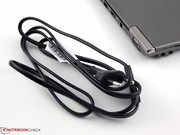Review Toshiba Satellite Z830-10J Ultrabook

Toshiba starts off into the era of high performance subnotebooks with the Satellite Z830. As an ultrabook, the 13.3 inch device promises a battery runtime of five hours and a system boot in less than seven seconds. The device places itself seamlessly in the list of comprehensively reviewed ultrabooks, which are almost all available on the German market.
Our review Acer Aspire S3-951 (13.3 inch)
Our review Asus Zenbook UX31 (13.3 inch)
Our review Asus Zenbook UX21 (11.6 inch)
Our review Lenovo IdeaPad U300s (13.3 inch)
Case
Toshiba sticks to its line and transfers the look & feel (materials) of its Portégé and Satellite R models to the new device category. Although the silver looks and the partly brushed surface (wrist rest, lid) suggest aluminum, the case is made of a light magnesium aluminum alloy with a honeycomb structure (inside). The latter give the perceptibly thin surfaces a good stiffness.
The manufacturer's aim is clear: The ultrabook should be as light-weight as possible and as stable as necessary. The attempt is successful because the 1110 gram, 13.3 inch Z830 weighs less than the 11.6 inch Asus Zenbook UX21 (1147 grams). The 13.3 inch Toshiba Z830 even has a longer battery life. In contrast, the other ultrabooks are real heavy-weights: Aspire S3 (1400 grams), Asus Zenbook UX31 (1300 grams), Lenovo IdeaPad U300s (1300 grams).
The wrist rest, single areas on the bottom and the display lid can be dented with little force. This does not diminish the quality because Toshiba ensures a very good torsional stiffness of the base unit due to an inner reinforcement. The case is even supposed to survive a drop test from a height of 76 cm on a steel plate (on its sides). The manufacturer let the Technical Control Board execute this test in addition to a pressure test (100 kg surface), which the Z830 passed. In an analogy to the plastic apron for cars, it can be said: It's probably just the slightly yielding chassis that makes the Z830 resistant.
The almost wafer-thin lid warps very easily and looks more like a piece of cardboard. The hinges fit tight on the case and let the lid stop softly at about 135 degrees. The hinges could use a bit more traction, though. The lid closes on its own when the device is shaken.
The lid has a narrow rubber lip at its upper edge that lies on the case when it's closed. The small gap that needs a fingernail to be opened is impractical in hectic situations. The device's bottom is absolutely even and there is no maintenance opening. The RAM (2 GB built-in, 2 GB inserted) can be upgraded. The entire bottom can be removed for this.
Connectivity
The seemingly well thought-out ports make the Z830 more practical than for example an Asus UX31. While, in the Asus, micro HDMI and mini VGA require an adapter and no Ethernet port is installed, the Z830 has these ports in full size. The trick to avoid making the chassis thicker: VGA and Ethernet are located above the rear feet.
It's practical that the majority of ports are located at the rear. The desk remains free of a visible cable mess, with exception of audio and USB 3.0. Only the Acer Aspire S3-951 has ports on the rear, but VGA and LAN have been completely omitted. Those looking for a docking port should remember that this is a Satellite. We are dealing with the consumer range. It's doubtful if the Portégé ultrabook will have such a port: The identically built Portégé Z830, available in the USA, also lacks a docking port (but has vPro and TPM module, i7 2677M).
Communication
WLAN in the latest n-standard belongs to the basic configuration meanwhile. A 3G module with built-in SIM slot would have been very suitable for the claim on mobility. But Toshiba unfortunately doesn't have such a version in its range. We will have to wait for a Portégé ultrabook. The Portégé Z830 versions available in the USA don't have this feature. But that doesn't necessarily mean anything for the (future) German models.
Accessories
Toshiba installs a set of tools and software on the hard disk. When looking closer, we find a few useful tools, such as Nero 10 Essentials (burn data carriers, manage multimedia files), Office Starter (Word + Excel), Recovery Media Creator or Eco Utility. The latter enables energy settings, preset by the manufacturer. Cheating isn't allowed for real energy savers and ecologists: The Eco mode settings may not be altered.
An Intel core processor and a WLAN module of the same manufacturer provide Wireless Display: If a TV with this feature is within reach, the Intel HD Graphics 3000 can transmit the colorful pixels to it. There are many USB ports for recharging the smartphone or iPod when the notebook is turned off. Toshiba however adds a tool which allows an exact setting of this function (minimum charge state).
Webcam
A 1.3 MP webcam isn't anything special at first. The picture quality is also limited, at least in poor light conditions. The picture shows noise and is a bit unfocused. However, we liked the simple user interface without the colorful gimmicks of a CyberLink YouCam.
Warranty
The laptop comes with a 24 month warranty. An onsite pick-up service is available in Germany and Austria, when the repair is registered via the Toshiba hotline. A warranty extension up to three years including a pick-up service costs about 65€.
Input Devices
Keyboard
Toshiba equips its Z830 with free-standing keys that are in a recess. It is exactly the same keyboard as in the sister model, Portégé R830-110 in terms of layout and lettering. The keys have a firm stroke. Their smooth surface is pleasant to use and doesn't leave any greasy fingerprints behind. The large key gap enables accurate typing, whereby the typing feedback seems too short. The reason is the low key drop. The keys also don't have a concave indentation (inward) and the marks for touch-typists on F and J are difficult to discern.
The layout is good. The arrow keys are separated, the "PG" keys as well as "DEL" and "Home/End" are sensibly located at the very right; "Caps Lock" lights up when active. Our focus turns to the keys' backlight at the keyword "light". It facilitates typing in the dark or during a blackout in the office.
In a video, the manufacturer shows how 100 ml coffee is poured over the keys of the Z830 in a spill test. The device remains in working order, although the liquid isn't drained. Therefore, coffee lovers should always drink one half of their brew before pouring the rest over the keys. A big cup of coffee has a capacity of at least 150 ml.
Touchpad
The multitouch pad (Synaptics v7.5) has a horizontal and vertical scroll bar, which isn't marked visibly. The newest pad driver version includes three-finger pressure support. This gesture can be mapped with an application that is then opened. The glossy keys have a short drop. Their high-pitched click noise isn't annoying, but the keys are stiff. Fast clicking becomes tedious due to that.
Display
The non-glare 13.3 inch screen (model can't be read out) doesn't live up to the ultra claim. We are dealing with a standard resolution of 1366x768 pixels, which won't impress demanding users. However, it is adequate for the consumer range. The good average brightness of 260 cd/m2 is praiseworthy.
| |||||||||||||||||||||||||
Brightness Distribution: 81 %
Center on Battery: 262 cd/m²
Contrast: 136:1 (Black: 1.93 cd/m²)
38.85% AdobeRGB 1998 (Argyll 3D)
56.2% sRGB (Argyll 3D)
37.58% Display P3 (Argyll 3D)
The weak contrast of 136:1 lets colors, as a consequence of the matt screen surface, look rather pale and dull. A black background doesn't look deep black, but has a gray cast. This is acceptable for office or outdoor use. However, users who have a high demand on screens and are looking for a wide color spectrum will be disappointed. sRGB is clearly failed (center picture). A business laptop, such as the Sony Vaio SE1Z9EB, is superior here, even if sRGB isn't covered by the Vaio screen.
The advantage of the Z830 Panel is its good brightness that doesn't dim on battery power, and which is fundamental for working in daylight. We measure the brightest spot on the outer left with 278 cd/m2. This and the anti-reflective coating are very beneficial for mobile users.
In the following video, we see the Z830 in various viewing angles. We'd like to depict what the image looks like from different positions. Simple TN screens, as built into the majority of notebooks as well as the Z830, only bid tight viewing angles of about 45 degrees horizontally. So-called ghosting turns up at wider angles, which will be familiar to everyone who looks at pictures or movies on a laptop. Narrow viewing angles are also the case in the Z830. We have to reckon with even stronger restrictions vertically. A deviation of only a few degrees up or downward distort the colors and the brightness decreases. We already notice ghosting at 10 degrees.
Performance
The Intel Core i5 2467M (default: 1.60 GHz, Turbo up to 2.30 GHz) is an energy efficient, ultra low voltage dual core processor from the 2011 Intel Core generation (Sandy Bridge). It is currently the only available CPU alternative for the Z830 in Germany. The identical Portégé Z830 is sold with an i7 2677M or even i3 2367M processor in the USA. The former is installed in the Asus Zenbook UX21E, an 11.6 inch device.
The RAM has the usual capacity of 4 GB (DDR3). Two gigabytes are soldered to the mainboard (on board), and two are inserted. The Intel HD Graphics 3000 is integrated on the CPU (shared memory). The Z830's actual acceleration during work is provided by its 128 GB mSATA 300 SSD from Toshiba (Toshiba SG2 Series, 32 nm, THNSNB128GMCJ). The price in (very rare) retail: 260€. The slim case doesn't accommodate a 2.5 or 1.8 inch disk, but a module with a size of 3x6 centimeters instead.
Processor
The (1.6 GHz) Core i5 2467M's TDP is 17 watts (35 and 45 watts are usual for laptops). In contrast to the Intel Core i7 2620M (dual core, 35 watts) frequently used in 13 inch devices lately, the TDP is a lot lower. However, the standard clock is also comparatively low. But just how much slower does the low voltage i5 calculate in comparison to a 2620M, as it's for example built into a Vaio SA2Z9E (13.3 inch)?
The processor test, Cinebench R11.5 (64 bit, multi core processing) rewards the Z830 with 1.91 points. This result is duplicated in all repetitions as well as on battery power (3 runs each). The 2620M manages 3.03 points and the i7 2677M, in the UX21E, 2.13 points. Our ultrabook with a Core i5 CPU is thus only a bit below the processing speed of a Core i7 ULV processor. However, it can only just keep up with the Core i3 2330M (2.1 points) among normal laptop processors.
Turbo 2.0 does its job without complaint. That isn't a matter of course in a slim case. The clock during the Cinebench multi core test was 2.1 GHz. The clock drops to (stable) 2.0 GHz at most when Prime95 simulates high load on all cores. This is within the Turbo range and is well above the standard clock of 1.6 GHz. Short: Turbo 2.0 works perfectly in our CPU benchmarks.
System Performance
PCMark Vantage and PCMark 7 both assess the application performance as a whole. The results of the Z830 is 8731, respectively 2951 points. This seems little when compared with the Asus UX21E (11054 and 3612 points) or the Samsung Series 9 900X3A (10833 and 3448 points). Normal i7 dual core notebooks without an SSD only achieve about 2000 points (Vostro 3350). The subjective speed is agreeably fast. Installations are finished in no time and programs are loaded within fractions of a second.
| PCMark Vantage Result | 8731 points | |
| PCMark 7 Score | 2951 points | |
Help | ||
Mass Memory
The reason for the Z830's speed is the Toshiba SSD's access rates. It boosts the PCMark Vantage HDD score to 18513 points. The ultimate top position, and thus one of the fastest SSDs, is found in the Asus UX21E: 42351 points. The 13.3 inch Samsung 900X3A "only" managed 15599 points and the Vaio Z13, with a Quad SSD, achieved 13055 points here. Notebooks with rotating hard disks (7200 rpm) achieve 6200 points at most.
The read and write rates are hidden behind the HDD scores of the system benchmarks, which we determine with HDTune, CrystalDiskMark and AS SSD. According to the tests, the SSD reads out the memory with a speed of 133 to 184 MB/s. The read/write rates of 4K data blocks isn't as convincing.
| 3DMark 06 Standard Score | 3769 points | |
| 3DMark Vantage P Result | 1622 points | |
Help | ||
Gaming Performance
As in the Asus UX21E, the integrated Intel HD Graphics 3000 (DirectX 10) shows that it's not suitable for current games. We tried Anno 2070, which is only playable in the lowest details and in 1024x768 pixels. 3D benchmarks, such as 3DMark 2006, turn out very poor with 3769 points.
Emissions
System Noise
The biggest flaw of the Z830 is, in our opinion, its penetrating, humming fan. This noise isn't high-pitched and is therefore inconspicuous in the measurements. Its vibrating and slightly buzzing quality will however annoy sensitive users.
The noise level is between 31 and 33 dB (A) when surfing on the Web and working in Word. The fan whirs consistently at 39 dB (A) during permanent load for processor and integrated HD 3000. The fan can get even louder, though: We measure 41.6 dB (A) while playing Anno 2070. However, we set the settings of the Intel HD to "High Performance" (default: Balanced). When the load is finished, the fan management regulates the speed and also the level down to 33 dB (A) within two minutes.
Noise Level
| Idle |
| 31.4 / 31.4 / 33 dB(A) |
| Load |
| 38 / 38.7 dB(A) |
 | ||
30 dB silent 40 dB(A) audible 50 dB(A) loud |
||
min: | ||
Temperature
The temperature development doesn't blunder. Single regions only get lukewarm in idle and office mode (up to 30 degrees Celsius). This clearly changes during load. The temperature peak is 42 (top) and 43 degrees Celsius (bottom) during the stress test, which is still within an acceptable range. Note: The wrist rest remains cool at all times and never surpasses 27 degrees.
(±) The maximum temperature on the upper side is 41.5 °C / 107 F, compared to the average of 35.9 °C / 97 F, ranging from 21.4 to 59 °C for the class Subnotebook.
(±) The bottom heats up to a maximum of 43.4 °C / 110 F, compared to the average of 39.3 °C / 103 F
(+) In idle usage, the average temperature for the upper side is 25.3 °C / 78 F, compared to the device average of 30.8 °C / 87 F.
(+) The palmrests and touchpad are cooler than skin temperature with a maximum of 26.3 °C / 79.3 F and are therefore cool to the touch.
(±) The average temperature of the palmrest area of similar devices was 28.2 °C / 82.8 F (+1.9 °C / 3.5 F).


Speakers
Both speakers are on the front below the wrist rest. Music playback emits a sound focused on the mid and without low ranges. It's satisfactory for home use or a presentation. External speakers or high quality headphones are advisable for music consumption. The Dolby Equalizer (tool, see picture) makes most sense with connected speakers. The headphone test via the 3.5 mm jack didn't show any irregularities, such as noise.
Battery Life
Power Consumption
The consumption measurements from the outlet (battery charge: 100%) show a modest ultrabook. We only measured five watts in idle (minimum). The TFT screen can increase this up to 10 watts with maximum brightness, keyboard backlight and operating mode "High Performance" (CPU/GPU-idle). The Z830 fares well here; even the 11.6 inch Asus UX21E has a power consumption of 6.6 to 11.1 watts.
The power consumption triples in maximum load (36 watts). When the i5 2537M is busy with only the processor stress test, the Z830 consumes 31 watts (stable @ 2.0 GHz). The power consumption increases to 32 watts when the 3D benchmark, Furmark, is added.
| Off / Standby | |
| Idle | |
| Load |
|
Key:
min: | |
Battery Life
The Z830 can only meet Intel's demand for an ultrabook battery life of at least five, better seven, hours when the user limits his activities to reading or typing with dimmed light. The Z830 achieves a runtime of 4:27 hours in the WLAN test. The brightness was set to 100 cd/m2 for the test.
The Z830 needs three hours to recharge the built-in battery. When power-use can't be avoided, the battery is empty after 120 minutes. A look at the other ultrabooks shows that their battery life isn't much better: A Lenovo U300s manages five hours, an Acer Aspire S3 Ultrabook (HDD version, Core i5) only 3:30 hours (both WLAN test) and an Asus UX31 also only manages five hours.
Verdict
The Toshiba Satellite Z830 10J changes hands for a grand. The user benefits from the lightest 13.3 inch ultrabook (1110 grams) of all times. Even the MacBook Air 13 is heavier with 1330 grams. The magnesium aluminum lightweight construction is very similar to the Satellite or Portégé R series (see R830). However the weak points, such as the wobbly screen, have been eliminated.
Compared to other ultrabooks, the Z830 has many interfaces, and the majority is even handily located at the rear. The backlit keyboard unfortunately doesn't grant a business-style typing comfort due to its short key drop. However, the layout is very good. The battery life of 4:27 hours in practical use (WLAN test) regrettably fails Intel's 6 hour demand. Since 9:30 hours are possible in idle, users very well have optimization options when reading or typing emails. The matt and fairly bright screen displays pallid colors, but we can still recognize the content acceptably (doesn't dim on battery power).
We quite liked the performance with Toshiba's 128 GB SSD and Intel's Core i5 2467M (1.6 GHz), especially because the performance is never throttled (thermal throttling) and is even available on battery power (not GPU performance).
Unfortunately, the biggest drawback comes from the base plate: The fan permanently rotates audibly even though the measured level of 31.4 dB (A) is low. The buzzing quality will be annoying for the silent-PC fan. Toshiba should make improvements via fan management or constructive modifications. Until then, the fan will remain to be the only real fault of the otherwise overall well-designed Toshiba ultrabook.










